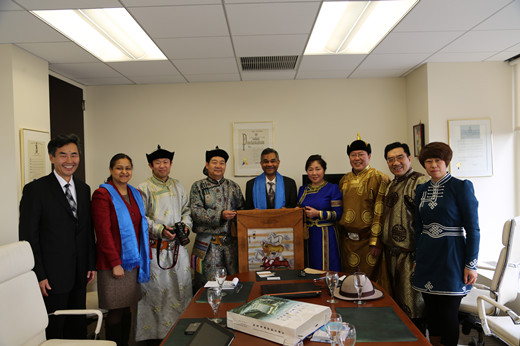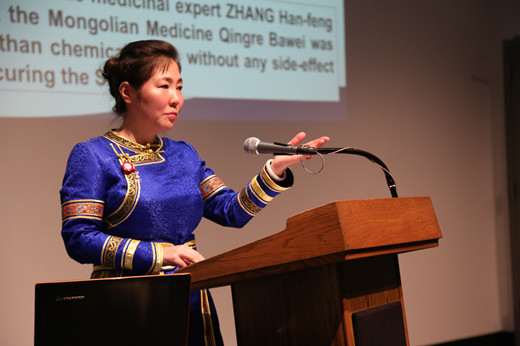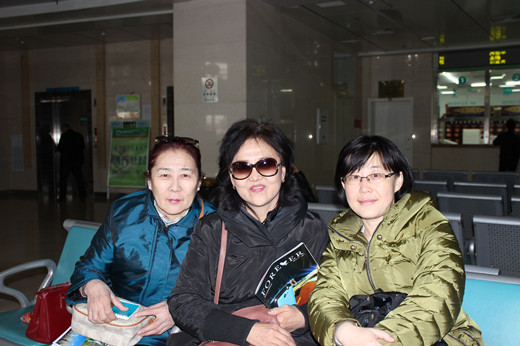 |
|
Experts in traditional Mongolian medicine attended the UN forum and delivered a speech entitled The function and role China's TMM has played in the lives of its urban and rural residents. During the forum, they were received by the WHO ambassador. |
I grew up in Hohhot, but like many who grow up in the capital of Inner Mongolia Autonomous Region, I understand Mongolian culture mostly from its unique music, dances, food and customs. It was not until a recent casual visit to the Inner Mongolia International Mongolian Hospital that I got a closer look at the ancient art of traditional Mongolian medicine.
Established in Hohhot in April 2012, the State-owned Inner Mongolia International Mongolian Hospital has received 8,000 patients from neighboring countries like Mongolia, Russia, and Poland within less than 3 years, said a staff member surnamed Sa from the hospital’s administrative department. It also attracted many Mongolian patients who had planned to go to Russia, Japan and South Korea to come here for treatment. The Inner Mongolia International Mongolian Hospital has actually become an important bridge for the friendly exchanges between the Chinese and Mongolian people.
 |
|
At the UN North/South Dialogue advanced forum, Ulaan, director of the Inner Mongolia International Mongolian Hospital, made a speech entitled The function and role China's TMM has played in the lives of its urban and rural residents. |
Mention Mongolian medicine, and you might think of the fantastic and mysterious acupuncture, bloodletting, bone-setting, brain vibration therapy, among other medical techniques. Doctor Han Guangming, a well-known encephalopathy expert in the Inner Mongolian International Mongolian Hospital and the academic heir of famous Mongolian doctor Chen Yuliang, said that traditional Mongolian medicine and traditional Chinese medicine are very much alike. Both operate on the Yin and Yang theory, the chills and fever theory and holism. Both hold that the human body is an organic whole, that different organs are closely related, and that there is an intimate connection between man and nature, and that man is an integral part of nature.
But it is in palm reading that they differ. Mongolian doctors read the palm for liver conditions using their right hand, but doctors of traditional Chinese medicine use their left hand. Traditional Mongolian medicine is derived from plants, animals and minerals in nature, and has to be taken at different times in the day according to the way human organs operate across the 24 hours of a day. Different medicines are taken at different times of the day, whether morning, noon or night.
 |
|
Famous traditional Mongolian doctor Agula in the Inner Mongolian Autonomous Region treats a patient with the traditional Mongolian brain vibration therapy. |
Doctor Han said that traditional Mongolian medicine found in many hospitals and drugstores in China now offers treatments for rheumatism, liver diseases, blood disorders, stomach problems and forms of dermatitis. But due to people’s lack of knowledge and the unfamiliarity of Mongolian medical terminology, it is difficult to promote traditional Mongolian medicine at home and abroad. So Dr. Han wishes fervently that the country would intensify its efforts to let more people know about the heritage of traditional Mongolian medicine.
In February 2013, the Inner Mongolian delegation of experts in traditional Mongolian medicine was invited to attend “Prosperity of Cities—North/South Dialogue Advanced Forum”, an international forum organized by the WTO in New York. Ulaan, deputy director of the Health Department of the Inner Mongolian Autonomous Region and director of the Inner Mongolia International Mongolian Hospital, made a speech entitled “The function and role China's TMM has played on the lives of its urban and rural residents”, attracting great attention from the ambassadors of different countries.
 |
|
The reporter takes a photo with two Mongolian ladies who came to the Inner Mongolian International Mongolian Hospital to attend lectures. |
While applauding the delegation for being the first to bring traditional Mongolian medicine from China to the UN podium, Jacob Kumaresan, the WHO ambassador to the United Nations, said that platforms and opportunities must be created for traditional Chinese medicine to go global.
The culture of Mongolian medicine has also been spread by art and media. The Seventh Flavor, a 2014 movie on traditional Mongolian medicine, won the award for best film at the Asian Film Festival (Rome), and allowed the whole world to experience the tastes of traditional Mongolian medicine and its seventh taste—universal love! The herbal fragrances of Mongolian medicine are superior to potpourri because they are purer and truer. Let’s hope that traditional Mongolian medicine will gain greater influence around the world!